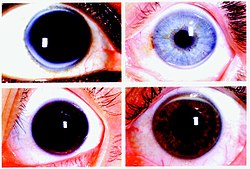Arcus senilis
(Redirected from Arcus corneae)
Editor-In-Chief: Prab R Tumpati, MD
Obesity, Sleep & Internal medicine
Founder, WikiMD Wellnesspedia &
W8MD medical weight loss NYC and sleep center NYC
| Arcus senilis | |
|---|---|

| |
| Synonyms | Arcus senilis corneae, corneal arcus |
| Pronounce | N/A |
| Specialty | N/A |
| Symptoms | White, gray, or blue opaque ring in the corneal margin |
| Complications | None |
| Onset | Commonly in elderly |
| Duration | Permanent |
| Types | N/A |
| Causes | Lipid deposits in the cornea |
| Risks | Hyperlipidemia, cardiovascular disease |
| Diagnosis | Clinical diagnosis |
| Differential diagnosis | Limbal girdle of Vogt, band keratopathy |
| Prevention | N/A |
| Treatment | None required |
| Medication | N/A |
| Prognosis | Benign |
| Frequency | Common in older adults |
| Deaths | N/A |
Arcus Senilis
Arcus senilis is a common ophthalmological condition characterized by a gray or white arc or ring around the cornea of the eye. This condition is often associated with aging and is considered a normal finding in older adults. It is also known as corneal arcus or arcus lipoides.
Pathophysiology
Arcus senilis occurs due to the deposition of lipids in the peripheral cornea. These lipids are primarily cholesterol and phospholipids, which accumulate in the corneal stroma. The condition is typically bilateral, meaning it affects both eyes, and the arc or ring is usually located at the corneal periphery, sparing the central cornea.
Clinical Presentation
Arcus senilis appears as a white, gray, or blue opaque ring in the corneal margin. It is more common in older adults, typically appearing after the age of 50. In younger individuals, the presence of arcus senilis may indicate hyperlipidemia or other lipid metabolism disorders.
Diagnosis
The diagnosis of arcus senilis is primarily clinical, based on the characteristic appearance of the corneal ring. An ophthalmologist can easily identify the condition during a routine eye examination using a slit lamp.
Significance
While arcus senilis is generally considered a benign condition in the elderly, its presence in younger individuals may warrant further investigation for underlying lipid disorders. In such cases, a lipid profile test may be recommended to assess cholesterol levels and evaluate the risk of cardiovascular disease.
Management
Arcus senilis itself does not require treatment, as it does not affect vision or cause any symptoms. However, if it is associated with hyperlipidemia, managing the underlying lipid disorder is important to reduce cardiovascular risk.
Related Conditions
Arcus senilis should be differentiated from other corneal opacities and rings, such as Kayser-Fleischer ring, which is associated with Wilson's disease.
See also
Transform your life with W8MD's budget GLP-1 injections from $125.
W8MD offers a medical weight loss program to lose weight in Philadelphia. Our physician-supervised medical weight loss provides:
- Most insurances accepted or discounted self-pay rates. We will obtain insurance prior authorizations if needed.
- Generic GLP1 weight loss injections from $125 for the starting dose.
- Also offer prescription weight loss medications including Phentermine, Qsymia, Diethylpropion, Contrave etc.
NYC weight loss doctor appointments
Start your NYC weight loss journey today at our NYC medical weight loss and Philadelphia medical weight loss clinics.
- Call 718-946-5500 to lose weight in NYC or for medical weight loss in Philadelphia 215-676-2334.
- Tags:NYC medical weight loss, Philadelphia lose weight Zepbound NYC, Budget GLP1 weight loss injections, Wegovy Philadelphia, Wegovy NYC, Philadelphia medical weight loss, Brookly weight loss and Wegovy NYC
|
WikiMD's Wellness Encyclopedia |
| Let Food Be Thy Medicine Medicine Thy Food - Hippocrates |
Medical Disclaimer: WikiMD is not a substitute for professional medical advice. The information on WikiMD is provided as an information resource only, may be incorrect, outdated or misleading, and is not to be used or relied on for any diagnostic or treatment purposes. Please consult your health care provider before making any healthcare decisions or for guidance about a specific medical condition. WikiMD expressly disclaims responsibility, and shall have no liability, for any damages, loss, injury, or liability whatsoever suffered as a result of your reliance on the information contained in this site. By visiting this site you agree to the foregoing terms and conditions, which may from time to time be changed or supplemented by WikiMD. If you do not agree to the foregoing terms and conditions, you should not enter or use this site. See full disclaimer.
Credits:Most images are courtesy of Wikimedia commons, and templates, categories Wikipedia, licensed under CC BY SA or similar.
Translate this page: - East Asian
中文,
日本,
한국어,
South Asian
हिन्दी,
தமிழ்,
తెలుగు,
Urdu,
ಕನ್ನಡ,
Southeast Asian
Indonesian,
Vietnamese,
Thai,
မြန်မာဘာသာ,
বাংলা
European
español,
Deutsch,
français,
Greek,
português do Brasil,
polski,
română,
русский,
Nederlands,
norsk,
svenska,
suomi,
Italian
Middle Eastern & African
عربى,
Turkish,
Persian,
Hebrew,
Afrikaans,
isiZulu,
Kiswahili,
Other
Bulgarian,
Hungarian,
Czech,
Swedish,
മലയാളം,
मराठी,
ਪੰਜਾਬੀ,
ગુજરાતી,
Portuguese,
Ukrainian
Contributors: Prab R. Tumpati, MD



